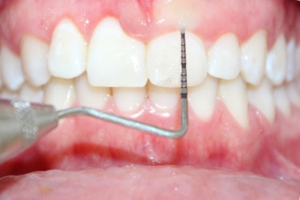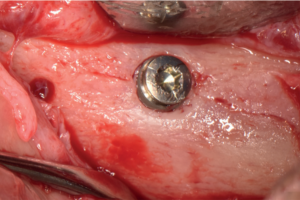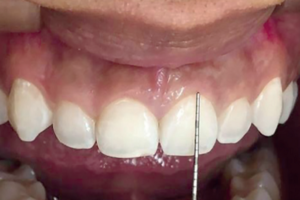Trabalho apresenta caso de reabilitação oral por meio de coroa em dissilicato de lítio, executado através do fluxo digital de trabalho, sob o conceito chairside.
AUTORES
Tatiana Cursino Pereira
Mestranda do Depto. de Odontologia Restauradora, do programa de pós-graduação em Ciências Aplicadas à Saúde Bucal – ICT-Unesp.
Orcid: 0000-0003-2393-0123.
Sabrina Elise Moecke
Mestra e doutoranda do Depto. de Odontologia Restauradora, do programa de pós-graduação em Ciências Aplicadas à Saúde Bucal – ICT-Unesp.
Orcid: 0000-0001-5523-3280.
Marco Antonio Bottino
Professor titular do programa de Odontologia Restauradora, Materiais Odontológicos e Prótese – ICT-Unesp.
Orcid: 0000-0003-0077-3161.
Renata Marques de Melo Marinho
Professora do Depto. de Odontologia Restauradora, Materiais Dentários e Prótese Dentária – ICT-Unesp.
Orcid: 0000-0003-0752-6294.
Guilherme de Siqueira Ferreira Anzaloni Saavedra
Professor do Depto. de Odontologia Restauradora, Materiais Dentários e Prótese Dentária – ICT-Unesp.
Orcid: 0000-0001-7108-0544.
RESUMO
Este trabalho teve como objetivo apresentar um caso de reabilitação oral por meio de coroa em dissilicato de lítio, executado através do fluxo digital de trabalho, sob o conceito chairside. O fluxo digital de trabalho se tornou uma realidade na Odontologia nos últimos anos. A evolução dos materiais restauradores abre um leque de possibilidades para tratamentos com eficiência e rapidez. Trabalhos que anteriormente envolviam inúmeros passos e dependiam de uma boa comunicação entre o cirurgião- -dentista e o técnico em Prótese Dentária, hoje podem ser executados em sessão única pelo cirurgião-dentista, em seu consultório. Apesar da simplificação das etapas, a tecnologia exige treinamento e estudo do profissional. A aplicação da tecnologia no ambiente odontológico requer uma curva de aprendizagem do profissional que a executa. A escolha do material é um fator importante para o sucesso clínico da restauração. O dissilicato de lítio é uma cerâmica que apresenta bom desempenho estético e funcional, viabilizando preparos dentários conservadores. Por ser um material monocromático, se faz necessária a caracterização da peça para que ela apresente maior naturalidade. As produções a partir da tecnologia CAD/CAM permitem alta precisão quanto à adaptação. O sistema oferece soluções ágeis e competentes para regiões posteriores. No entanto, são necessários mais estudos que avaliem o custo-benefício do conceito onesit a longo prazo nas restaurações confeccionadas pelo método digital.
Palavras-chave – CAD/CAM; Reabilitação bucal; Coroa dentária; Cerâmica.
ABSTRACT
The aim of this study is to present a case of oral rehabilitation, using a lithium disilicate crown, produced through digital workflow. Digital workflow has become a reality for dentistry in recent years. The evolution of restorative materials offers a range of possibilities for treatments with efficiency and speed. Work that previously involved numerous steps and depended on good communication between dentist and prosthesis laboratory technician, can now be completed by the dentist office in a single session. Despite the steps of simplification, the technology demands professional training and study. The technology application in dentistry requires a learning curve for the professional who performs it. The material selection is a crucial component for clinical success. Lithium disilicate is a ceramic that presents good aesthetic and functional performance, allowing conservative dental preparations. Since it is a monochromatic material, is necessary a piece characterization in order to result in a more natural. The use of CAD/CAM technology produces high precision work in terms of adaptation. The system offers agile and competent solutions for posterior areas. However, more long-term research on digital restorations is required.
Key words – CAD/CAM; Mouth rehabilitation; Tooth crown; Ceramic.
Recebido em dez/2021
Aprovado em dez/2021
Referências
- Bottino MA, Faria R, Valandro LF. Percepção: estética em próteses livres de metal em dentes naturais e implantes. São Paulo: Editora Artes Médicas Ltda., 2009.
- Schlichting LH, Schlichting KK, Stanley K, Magne M, Magne P. An approach to biomimetics: the natural CAD/CAM restoration: a clinical report. J Prosthet Dent 2014;111(2):107-15.
- Farias IA, Lima RR, Andrade AO, Luna AVL, Vasconcelos MG, Vasconcelos RG. Sistema CAD-CAM: a tecnologia na confecção de próteses. Salusvita 2018;37(4):963-83.
- Saavedra G, Viegas DMCCP, Costa F, Kano P. Biological restorations: a foreseeable possibility in the junction between dentistry and technology. Brazilian Dental Science 2019;22(3):413-24.
- Correia ARM, Fernandes JCAS, Cardoso JAP, Silva CFCL. CAD-CAM: a informática a serviço da prótese fixa. Revista Odontológica da Unesp 2006;35(2):183-9.
- Kayatt FE, das Neves FD. Contextualização histórica. In: Aplicação dos sistemas CAD/CAM na Odontologia Restauradora. Rio de Janeiro: Elsevier, 2013. p.1-12.
- Stanley M, Paz AG, Miguel I, Coachman C. Fully digital workflow, integrating dental scan, smile design and CAD-CAM: case report. BMC Oral Health 2018;7;18(1):134.
- Bottino MA. CAD/CAM: o contexto multidisciplinar da relação clínico-laboratorial. ImplantNews 2013;10(2):3.
- Fitzpatrick M. Introdução aos processos de usinagem. Porto Alegre: AMGH, 2013.
- Blatz MB, Conejo J. The current state of chairside digital dentistry and materials. Dent Clin North Am 2019;63(2):175-97.
- Sulaiman TA, Camino RN, Cook R, Delgado AJ, Roulet JF, Clark WA. Time-lasting ceramic stains and glaze: a toothbrush simulation study. J Esthet Restor Dent 2020;32(6):581-5.
- Kanat-Ertürk B. Color stability of CAD/CAM ceramics prepared with different surface finishing procedures. J Prosthodont 2020;29(2):166-72.
- Rapone B, Palmisano C, Ferrara E, Di Venere D, Albanese G, Corsalini M. The accuracy of three intraoral scanners in the oral environment with and without saliva: a comparative study. Applied Sci 2020;10(21):7762.
- Chen Y, Zhai Z, Li H, Yamada S, Matsuoka T, Ono S et al. Influence of liquid on the tooth surface on the accuracy of intraoral scanners: an in vitro study. J Prosthodont 2021;31(1):59-64.
- Ashraf Y, Sabet A, Hamdy A, Ebeid K. Influence of preparation type and tooth geometry on the accuracy of different intraoral scanners. J Prosthodont 2020;29(9):800-4.
- Park JM, Kim RJ, Lee KW. Comparative reproducibility analysis of 6 intraoral scanners used on complex intracoronal preparations. J Prosthet Dent 2020;123(1):113-20.
- Dutton E, Ludlow M, Mennito A, Kelly A, Evans Z, Culp A et al. The effect different substrates have on the trueness and precision of eight different intraoral scanners. J Esthet Restor Dent 2020;32(2):204-18.
- Winkler J, Gkantidis N. Trueness and precision of intraoral scanners in the maxillary dental arch: an in vivo analysis. Sci Rep 2020;10(1):1172.
- Tomita Y, Uechi J, Konno M, Sasamoto S, Iijima M, Mizoguchi I. Accuracy of digital models generated by conventional impression/plaster-model methods and intraoral scanning. Dent Mater J 2018;37(4):628-33.
- Nagy Z, Simon B, Mennito A, Evans Z, Renne W, Vág J. Comparing the trueness of seven intraoral scanners and a physical impression on dentate human maxilla by a novel method. BMC Oral Health 2020;20(1):97.
- Al Hamad KQ, Al-Rashdan RB, Al-Rashdan BA, Baba NZ. Effect of milling protocols on trueness and precision of ceramic crowns. J Prosthodont 2021;30(2):171-6.
- Haralur SB, Alqahtani NRS, Mujayri FA. Effect of hydrothermal aging and beverages on color stability of lithium disilicate and zirconia based ceramics. Medicina (Kaunas) 2019;55(11):749.
- Motro PF, Kursoglu P, Kazazoglu E. Effects of different surface treatments on stainability of ceramics. J Prosthet Dent 2012;108(4):231-7.
- Palla ES, Kontonasaki E, Kantiranis N, Papadopoulou L, Zorba T, Paraskevopoulos KM et al. Color stability of lithium disilicate ceramics after aging and immersion in common beverages. J Prosthet Dent 2018;119(4):632-42.





